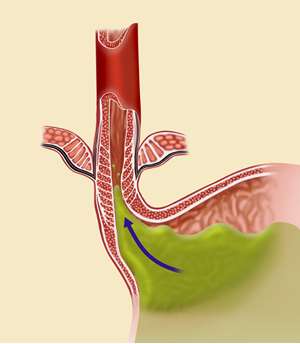The LINX® Reflux Management System
 Surgeons in the GERD and Gastrointestinal Surgery Program are the first in the area to offer a brand new, innovative device designed to treat gastroesophageal reflux disease (GERD) – the LINX® reflux management system. The LINX system is a small flexible band of interlinked titanium beads with magnetic cores designed to restore the body’s natural barrier to reflux in patients with GERD.
Surgeons in the GERD and Gastrointestinal Surgery Program are the first in the area to offer a brand new, innovative device designed to treat gastroesophageal reflux disease (GERD) – the LINX® reflux management system. The LINX system is a small flexible band of interlinked titanium beads with magnetic cores designed to restore the body’s natural barrier to reflux in patients with GERD.
Surgeons who specialize in the management of gastroesophageal reflux disease (GERD) at the Medical College of Wisconsin are the first in the area to offer treatment with an innovative device designed to treat GERD.
What is it? The LINX® Reflux Management System (LINX device) consists of a series of titanium beads, each with a magnetic core, connected together with titanium wires to form a ring shape. The LINX device is surgically implanted around the lower end of the esophagus. It is used to treat gastroesophageal reflux disease (GERD) in patients who continue to have GERD symptoms despite the use of medical therapy (acid pills such as proton pump inhibitor medications) for the treatment of their reflux.
 How does it work? The LINX device is implanted around the lower esophageal sphincter (a sphincter is a muscle that surrounds and closes a bodily opening) to strengthen a weak sphincter. Using the device helps to prevent the contents of the stomach from backing up into the esophagus (reflux). By restricting the flow of stomach contents into the esophagus, the patient will improve their heartburn symptoms and reflux (regurgitation) and may no longer require medicines to treat these symptoms.
How does it work? The LINX device is implanted around the lower esophageal sphincter (a sphincter is a muscle that surrounds and closes a bodily opening) to strengthen a weak sphincter. Using the device helps to prevent the contents of the stomach from backing up into the esophagus (reflux). By restricting the flow of stomach contents into the esophagus, the patient will improve their heartburn symptoms and reflux (regurgitation) and may no longer require medicines to treat these symptoms.
Even though the LINX device helps to prevent stomach contents from flowing back into the esophagus, it does not prevent movement of food or liquids down the esophagus into the stomach. When the patient swallows, the pressure in the esophagus increases and the magnetic beads move apart on the titanium wires. As the beads move apart, the magnetic force decreases. This separation of the beads allows food or liquids to pass normally into the stomach. After the food or liquids have passed into the stomach, the magnetic beads return to the closed position.
When is it used? The LINX device is used in patients who continue to have symptoms of GERD, such as heartburn and reflux, despite maximum medical therapy (daily use of medicines such as proton pump inhibitors). It is intended to be used in patients who would also be considered candidates for anti-reflux surgery.
What will it accomplish? The LINX device will help prevent abnormal amounts of acid from the stomach moving back into the esophagus. A growing body of literature supports the safety, efficacy, and long-term durability of this treatment. In a recently published 5-year follow-up of the patients who had a LINX device implanted as a part of the FDA trial, there were no device erosions, migrations, or malfunctions noted. Control of GERD symptoms was excellent with regurgitation reported in only 1% of patients at 5 years. All patients reported the preserved ability to belch and vomit if needed. Bothersome dysphagia (difficulty swallowing) was present in 5% prior to surgery and 6% at 5 years ("Long-term Outcomes of Patients Receiving a Magnetic Sphincter Augmentation Device for Gastroesophageal Reflux").


Patients who have the LINX device should not be exposed to, or undergo, an MRI (Magnetic Resonance Imaging) in a magnet more powerful than 1.5 Tesla for the current version of the device. Exposure to the more powerful MRI could cause serious injury to the patient and the device may be damaged.
For more information on the LINX device and whether this treatment might be right for you, contact us. Make sure you ask for a Minimally Invasive GERD and Gastrointestinal Surgeon in the MCW Division of Minimally Invasive and Gastrointestinal Surgery.
For more information on the LINX device, follow these links:

